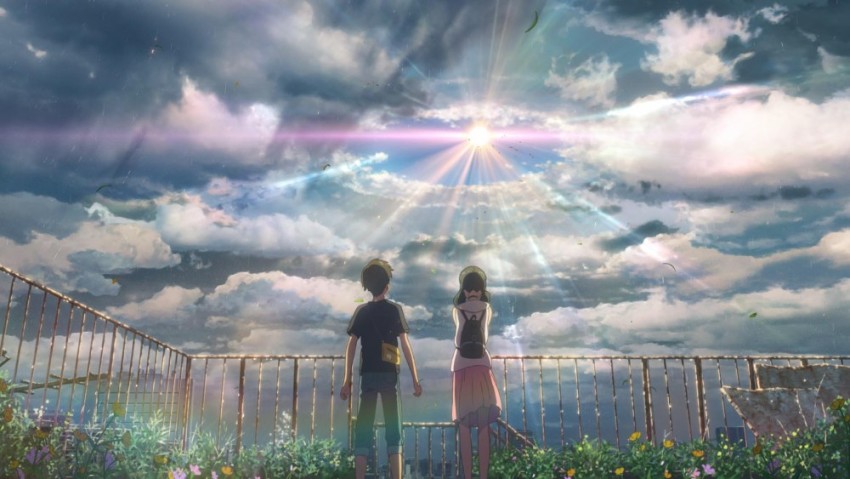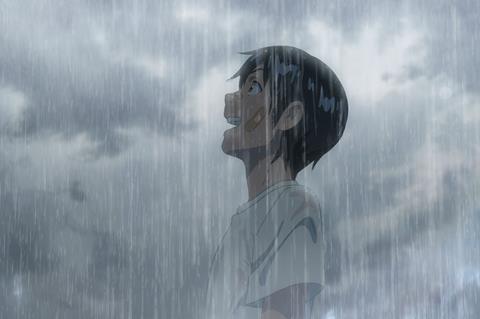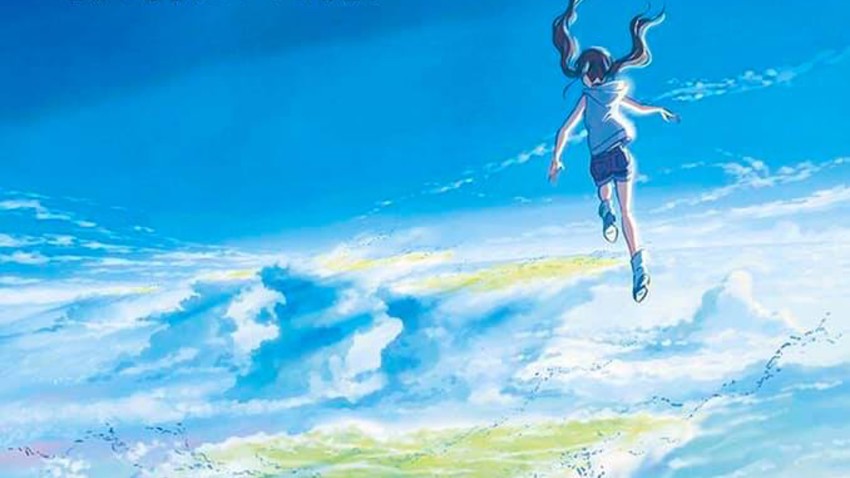Weathering with You
October 6, 2019 · 0 comments
By Andrew Osmond.
 By most counts, Weathering with You may be Makoto Shinkai’s seventh film – and his fifth to run over an hour – but you might also call it his difficult “second” album. In 2016, Your Name’s stunning commercial success catapulted Shinkai as if he’d been struck by that film’s rogue comet. Before, Shinkai was an acclaimed but niche director with a loyal fan following – big in anime fandom, but barely-known outside it. After Your Name, Shinkai was a maker of blockbusters like Spielberg or Miyazaki.
By most counts, Weathering with You may be Makoto Shinkai’s seventh film – and his fifth to run over an hour – but you might also call it his difficult “second” album. In 2016, Your Name’s stunning commercial success catapulted Shinkai as if he’d been struck by that film’s rogue comet. Before, Shinkai was an acclaimed but niche director with a loyal fan following – big in anime fandom, but barely-known outside it. After Your Name, Shinkai was a maker of blockbusters like Spielberg or Miyazaki.
Technically, Shinkai had still only made one blockbuster, but the Japanese marketing machine made sure Shinkai’s next film was pre-sold as a national event. Weathering with You opened on hundreds of screens across Japan in mid-July, welcoming in the summer. Toho, the film’s distributor, opened Weathering with You just a week after the Japanese release of Toy Story 4. The Shinkai brand was considered more than able to see off Buzz and Woody; how could Pixar’s toys fare against Shinkai’s star-crossed teenagers?
And Weathering with You is very much a Shinkai brand film, and most definitely has star-crossed teenagers. This time they’re Hodaka, a boy from a remote Japanese island who comes to Tokyo and flounders trying to build a life in the big city; and Hina, a girl who has magic-seeming power to control the weather. The story is largely told through Hodaka’s eyes – his narration fills the film – showing his haphazard arrival in Tokyo, his chance meeting with Hina, his wonder at her powers, and his deepening feelings for her.
The film frequently follows the Your Name template, which was already more like a Hollywood film than Shinaki’s earlier work. For example, when the teens look to be doing well in their partnership, that’s fair warning that things will soon get far tougher for them. Like Mitsuha, Hina has an outspoken younger sibling – a boy, Nagisa – to lighten many scenes. Most obviously, the story puts venerable Japanese belief systems into a present-day setting, even more than Your Name. In the previous film, the Shinto practices were associated with a remote country town. In Weathering, Hina’s powers impact directly on Tokyo, the setting for almost all of the film.
 However, the film is far from a Your Name clone. As commentators quickly noted, the early scenes in Tokyo have a surprising grittiness under the rueful humour. The boy Hodaka arrives in the city nearly penniless, holing up in a cybercafé, and glimpsing Tokyo’s seedy side – there’s a glimpse of Tokyo’s infamous “Vanilla” truck, which is decorated with manga-style faces but is actually inviting women to work in the sex trade. In one scene, Hodaka tries to play a white knight and gets a harsh lesson in the realities of poverty, going far darker than the sex jokes in Your Name.
However, the film is far from a Your Name clone. As commentators quickly noted, the early scenes in Tokyo have a surprising grittiness under the rueful humour. The boy Hodaka arrives in the city nearly penniless, holing up in a cybercafé, and glimpsing Tokyo’s seedy side – there’s a glimpse of Tokyo’s infamous “Vanilla” truck, which is decorated with manga-style faces but is actually inviting women to work in the sex trade. In one scene, Hodaka tries to play a white knight and gets a harsh lesson in the realities of poverty, going far darker than the sex jokes in Your Name.
There’s maybe a hint of Satoshi Kon’s film Tokyo Godfathers, but Hodaka’s situation – a teenage boy alone in a city of adults – has a more obvious reference for both Japanese and Western viewers. Very early, we see that Hodaka possesses a copy of Catcher in the Rye, a book already prominent in anime, in the “Laughing Man” strand of Ghost in the Shell Stand Alone Complex. Several of Hodaka’s experiences and decisions can be seen as those of a latter-day Holden Caulfield, determined to stay rebelliously pure and not play by the rules imposed by grown-ups.
Hodaka eventually ends up working with a couple of journalists writing for MU magazine, Japan’s equivalent of Britain’s Fortean Times, exploring mysteries and the supernatural. (MU is a very real magazine; Tessie was glimpsed reading it in Your Name.) The portrait of this small group, Tokyo-based but working outside the corporate mainstream, recalls the programmers in Eden of the East, whose director, Kenji Kamiyama, gave us the “Laughing Man” in Stand Alone Complex.
Anime like Eden and Tokyo Godfathers may have influenced Shinkai’s own aesthetic of extreme (if idealised) realism. Weathering may be the densest depiction of Tokyo in anime, showing from the city from the gutter up to its highest vantages, absurdly epic, and a likely reason for the film’s reported struggles to meet its release date. Central Tokyo districts including Shinjuku, Ikebukuro, seedy Kabukicho and waterside Odaiba are represented, along with prominent shots of the New National Stadium for the Olympics, which is under construction as of writing. Shinkai fans will be unsurprised his beloved Tokyo trains are all over the film, even shaking Hina’s house though she doesn’t mind a jot.
One incidental, perhaps coincidental point, is that a couple of short scenes feel remarkably close to Mamoru Hosoda’s Boy and the Beast, which was also largely set in central Tokyo – especially a moment when Hodaka flees police, then finds a diminutive non-human friend. It feels ironic, given Hosoda seemed on track to become “the” mainstream anime director in Japan after Miyazaki. Boy and the Beast was Hosoda’s biggest hit in Japan, but was utterly overshadowed by Shinkai’s Your Name.
 Beyond Tokyo, the spectacle comes from the film’s handling of the titular weather – an area where Shinkai proved himself six years ago when he based a whole anime around rain, Garden of Words. Weathering with You is enchanted with weather’s transitions and juxtapositions, which can make reality fantastical: sunbeams piercing rain, grey clouds replaced by a sublime sunset, instant shifts from one environment to another.
Beyond Tokyo, the spectacle comes from the film’s handling of the titular weather – an area where Shinkai proved himself six years ago when he based a whole anime around rain, Garden of Words. Weathering with You is enchanted with weather’s transitions and juxtapositions, which can make reality fantastical: sunbeams piercing rain, grey clouds replaced by a sublime sunset, instant shifts from one environment to another.
There are debts to Miyazaki; there were similar weather transitions in Princess Mononoke in a build-up to battle. Shinkai also borrows Miyazaki’s fascination with flooded spaces from Ponyo (which harks back to the 1973 kids’ film Panda! Go Panda! Rainy Day Circus, which Miyazaki made with Takahata). But Shinkai may have been equally influenced by Mamoru Oshii, who used weather with unequalled poeticism. Think of the rainfall during the canal scene in Oshii’s Ghost in the Shell, or the snow blanketing Tokyo in Patlabor 2.
Weather itself is linked to the realm of the supernatural, as the opening scenes make clear. In Japan, there are old stories and modern jokes about characters who attract good or bad weather (though it’s hardly unique to Japan – think how royal lions seem to control the weather in Disney’s Lion King). Teru teru bozu, miniature dolls that look like ghosts, appear through the film, traditionally made by Japanese kids to pray for good weather – Hina’s little brother dresses up as one.
The film also has passages to wondrous other realms, which a “lucky” human may traverse. But Japanese viewers, who grew up on stories like Urashima Taro, know such wonder journeys can come with terrible prices.
On a smaller scale, some motifs in Weathering follow Your Name directly. Count the eating scenes, including a lovely interlude where Hina shows Hodaka how to cook up a feast on a budget. Weathering continues Your Name’s focus on screens and social media; mobile texting and maps, a “fund-me” website, TV weather reports and emergency warnings. Then there are little details to catch on a rewatch. For example, some riverboats glimpsed in the last scenes look like tributes to the very “futuristic” boats designed by anime legend Leiji Matsumoto, already traversing Tokyo’s waterways.
 From the first trailer, Weathering trumpeted how much it was following Your Name’s template. It looks like Your Name, with the same ravishing spectacle, the same dense real detail, even the same character designer. That’s Masayoshi Tanaka, who often works on productions with Mari Okada, including Maquia, anohana and Anthem of the Heart. Tanaka is also much of the reason why last year’s mecha series DARLING in the FRANXX looked so good, whatever you thought of its story.
From the first trailer, Weathering trumpeted how much it was following Your Name’s template. It looks like Your Name, with the same ravishing spectacle, the same dense real detail, even the same character designer. That’s Masayoshi Tanaka, who often works on productions with Mari Okada, including Maquia, anohana and Anthem of the Heart. Tanaka is also much of the reason why last year’s mecha series DARLING in the FRANXX looked so good, whatever you thought of its story.
There’s a change in Animation Director, but only from one veteran of Studio Ghibli to another. Your Name’s Masahiro Ando bows out, replaced by Atsushi Tamura who – according to the Sakugabooru website – animated some of Spirited Away’s defining moments, including Chihiro discovering that her parents have become pigs, and feeding a thrashing dragon a vomitous antidote. In Weathering, many of the most eye-catching shots involve chases, both on foot and on a vehicle to draw whoops from young males. The latter chase ends with a stunt that looks inadvisable to try at home or anywhere else.
RADWIMPS, the band that scored all of Your Name, is back for the music, though the group rings a change by inviting a female vocalist onto two of the songs – actress Toko Miura, who doesn’t seem to voice a character, but has appeared in many live-action film and TV roles through the 2010s. While her vocals on “Grand Escape,” one of the songs, are prominent on the trailer, wait for how it’s used in the film, synched breathtakingly to the action as it turns fantastical.
Of Weathering’s Japanese cast, both Hodaka and Hina are played by newcomers, Kotaro Daigo and Nana Mori. This is a contrast to Your Name, where the teens were played by established actors; Daigo and Mori were chosen through a casting call of more than 2,000 hopefuls.
Although Hodaka and Hina are central, Weathering gives more room than Your Name to its support cast, especially Hodaka’s older co-workers at the “supernatural” magazine. The male Keisuke is voiced by prolific live actor Shun Oguri, who once played a live-action Lupin the Third. His co-worker Natsumi (their relationship isn’t immediately revealed) is played by actress-model Tsubasa Honda. Given Keisuke is lean and wily, and Natsumi is voluptuous (to Hodaka’s discomfort) and a daredevil, they may be Shinkai’s tribute to Monkey Punch.
A big-haired detective called Takai is voiced by the very familiar Yuki Kaji, most famous for his ongoing voice role as Eren in Attack on Titan. Also look out for a grandmotherly women called Tomi, voiced by Chieko Baisho, a regular in the Tora-san live-action films and the voice of Sophie (all ages) in Howl’s Moving Castle. As for cameos from past Shinkai characters, there seem to be a couple. However, given certain details, these may be alternative versions of the characters we’ve seen, much as a schoolteacher in Your Name seemed to be an alt-version of a character in Garden of Words.
This may provoke some fan discussion; however, the main debate will concern the film’s ending. Shinkai reportedly said before the film opened that Weathering with You would divide viewers. He’s also talked about how Your Name’s success meant it was reviewed and discussed far more than his previous anime, including (inevitably) more negative commentary. And we’ve already talked about how Your Name propelled Shinkai up to a blockbuster brand.
All this seems reflected upon in the last scenes of Weathering with You. Yes, they do serve up many things that Shinkai fans will expect, but there are also some jaw-dropping surprises and open provocations. They’re exactly the things to inspire angry online articles, ones that start by describing Weathering’s handling of certain subjects as “deeply problematic” and go south from there.
They also suggest a very cunning head-game with the audience. Shinkai could have almost had one of his characters turn to the audience and asking “But isn’t this what you loved in Your Name?” Yes it is, but some of the context is very different, as if Shinkai is asking us what his style, his passionate teens frantic to connect, actually means outside the movie.
Fittingly, the Tokyo screenings of Weathering with You were linked with another well-known anime brand which is known for turning round and confronting its audience, asking, “But what does this really mean”? Yes, the trailers in front of Weathering included one for next summer’s big anime film: Evangelion 3.0 + 1.0.
Weathering with You is screening at this year’s Scotland Loves Anime.
Leave a Reply